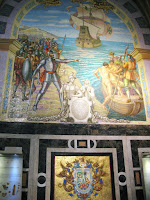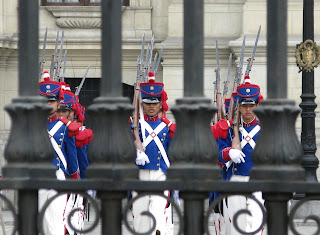Incas, Machu Picchu, the Lake Titicaca are the best-known highlights of Peru. Lima - the capital of the country remains somewhere aside. It is usually a stopover on the route.
The city is located on the edge of the desert, on the Pacific coast, at the mouth of the river Rimac. I would imagine it as another sunny South American city. But due to the phenomenon of thermal inversion it is covered with fog most of the year. Unpleasant fog disappears in the summer. But still the blue sky is not very common.

No matter what is your next destination in Peru, it is worth staying to see the city. Lima was the Viceroyalty. It means it was political, commercial and ecclesiastical center of the Spanish South America for two centuries. The city was founded in 1535 by Francisco Pizarro. His grave can be found in the chapel on the right side from the entrance to the Cathedral. It's hard to miss it because the chapel is decorated with frescoes and mosaics depicting Pizzaro as conqueror. It is interesting that the real remains of Pizzaro were moved to that chapel only in 1985. It was a part of celebration of the city's 450 anniversary.
The Cathedral is one of the most important and interesting monuments to see. Temple, which we visit today is actually the third Cathedral built on the same spot. The first two churches were built in the 16th century. The first was a small chapel consecrated in 1540. The second much larger church was built by Bishop Geronimo de Loayza 1551. The third cathedral was consecrated in 1622. Interior decoration of the cathedral is rich in styles. You will find good examples of decorative works in 14 chapels. There is a museum of sacred art in the former treasury and private rooms. You can see some interesting examples of local Christmas cribs and even special beds for the Christ Child.

The Cathedral is located at the Plaza Mayor. The square was formerly known as the Plaza de Armas (the name was changed in 1997). It is historic and administrative center of the city. You can find here the Palace of the Archbishop (Palacio del Arzobispo) with a stunningly decorated façade, the City Hall (Municipalidad de Lima) with beautifully restored wooden balconies and the Palacio de Gobierno (Presidential Palace). And there is a fountain with a statue of the Angel of Fame in the center of the square.
The Presidential Palace witnessed political struggles. It was where the first coup d’état in Latin America took place. Francisco Pizarro was murdered there in 1541. The present building comes from the 20th century, but the plan of the ground floor has been preserved from the original building. Every day, except Sundays, at noon there is a ceremony of the changing of the guard in the uniforms from the period of struggle for independence.
The square is a good starting point for a walk through the narrow streets of the old town. Well, see you next time.









